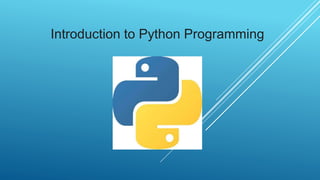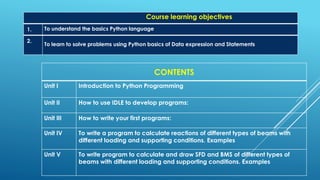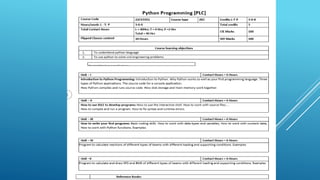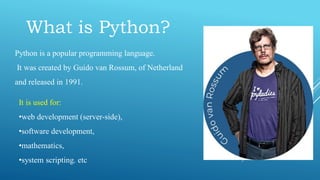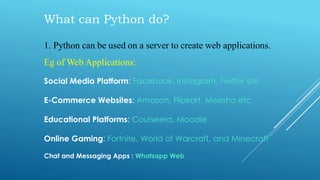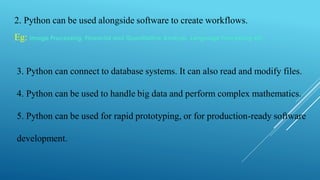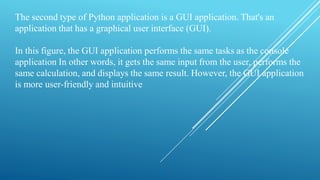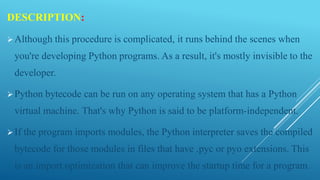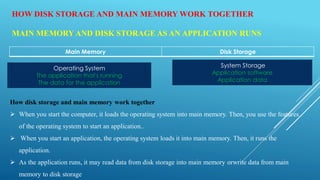Introduction to Python
- 1. Introduction to Python Programming
- 2. Course learning objectives 1. To understand the basics Python language 2. To learn to solve problems using Python basics of Data expression and Statements CONTENTS Unit I Introduction to Python Programming Unit II How to use IDLE to develop programs: Unit III How to write your first programs: Unit IV To write a program to calculate reactions of different types of beams with different loading and supporting conditions. Examples Unit V To write program to calculate and draw SFD and BMS of different types of beams with different loading and supporting conditions. Examples
- 6. INTRODUCTION Programming is writing computer code to create a program, in order to solve a problem. Programs consist of a series of instructions to tell a computer exactly what to do and how to do it. A programming language is a vocabulary and set of grammatical rules for instructing a computer or computing device to perform specific tasks.
- 10. What is Python? Python is a popular programming language. It was created by Guido van Rossum, of Netherland and released in 1991. It is used for: âĒweb development (server-side), âĒsoftware development, âĒmathematics, âĒsystem scripting. etc
- 11. 1. Python can be used on a server to create web applications. Eg of Web Applications: Social Media Platform: Facebook, Instagram, Twitter etc E-Commerce Websites: Amazon, Flipkart, Meesho etc Educational Platforms: Courseera, Moodle Online Gaming: Fortnite, World of Warcraft, and Minecraft Chat and Messaging Apps : Whatsapp Web What can Python do?
- 12. 2. Python can be used alongside software to create workflows. Eg: Image Processing, Financial and Quantitative Analysis, Language Processing etc 3. Python can connect to database systems. It can also read and modify files. 4. Python can be used to handle big data and perform complex mathematics. 5. Python can be used for rapid prototyping, or for production-ready software development.
- 13. Why Python is a great first language? âĒ Python has a simple syntax that's easier to read and use than most other languages. âŦ Python has most of the features of traditional programming languages. As a result, you can use Python to learn the concepts and skills that apply to those languages too. âŦ Python supports the development of a wide range of programs, including games, web applications, and system administration. âĒ Python is used by many successful companies, including Google, IBM, Disney, and EA Games. As a result, knowing Python is a valuable skill. Python is open source. There are many advantages to being open source.
- 14. THREE TYPES OF PYTHON APPLICATIONS An application, or app, is a computer software that perform a task or related set of tasks. ïķA console application is a desktop application that uses the Console to interact with the user
- 15. The first type is a console application. In this type of application, you enter commands at the command prompt in the console that's available from your operating system.(In this case, a console application is being run on a Windows system. As a result, it uses the Command Prompt window that's available from Windows. On a Mac OS X system, though, a console application runs in the Terminal window. Because console applications are the easiest type of application to develop, you'll work with console applications in the first three sections of this book
- 16. ïķA GUI application is an application that uses s Graphical User Interface to interact with the user
- 17. The second type of Python application is a GUI application. That's an application that has a graphical user interface (GUI). In this figure, the GUI application performs the same tasks as the console application In other words, it gets the same input from the user, performs the same calculation, and displays the same result. However, the GUI application is more user-friendly and intuitive
- 18. ïķA web application typically gets requests from a web browser, processes them on a web server, and returns the responses to the web browser
- 19. The third type of application shown in this figure is a web application.)Unlike a desktop application, which runs directly on your computer, a web application can be called by a web browser that's running on a computer or mobile device and can use a server to process or store data) In this figure, the web application performs the same task as the console and GUI applications)
- 20. How Python compiles and runs source code Step 1: The programmer uses a text editor or IDE to enter and edit the source code. Then, the programmer saves the source code to a file with a .py extension. Step 2 : The source code is compiled by the Python interpreter into bytecode. Step 3: The bytecode is translated by the Python virtual machine into instructions that can interact with the operating system of the computer.
- 21. DESCRIPTION: ïAlthough this procedure is complicated, it runs behind the scenes when you're developing Python programs. As a result, it's mostly invisible to the developer. ïPython bytecode can be run on any operating system that has a Python virtual machine. That's why Python is said to be platform-independent. ïIf the program imports modules, the Python interpreter saves the compiled bytecode for those modules in files that have .pyc or pyo extensions. This is an import optimization that can improve the startup time for a program.
- 22. HOW DISK STORAGE AND MAIN MEMORY WORK TOGETHER MAIN MEMORY AND DISK STORAGE AS AN APPLICATION RUNS Operating System The application that's running The data for the application System Storage Application software Application data Main Memory Disk Storage How disk storage and main memory work together ï When you start the computer, it loads the operating system into main memory. Then, you use the features of the operating system to start an application.. ï When you start an application, the operating system loads it into main memory. Then, it runs the application. ï As the application runs, it may read data from disk storage into main memory orwrite data from main memory to disk storage
- 23. .DESCRIPTION: ï The system software for a computer provides all of the software that is needed for running the applications, including the operating system. âĒ ï The applications software consists of the applications that are available on the system. ï A computer consists of a CPU (Central Processing Unit) and main memory, also known as RAM (Random Access Memory). ï The data in main memory is lost when an application ends. Disk storage is used for persistent data storage which remains after an application ends.âĒ ï Main memory and disk storage are commonly measured in megabytes (MB) and
- 24. THANK YOU

